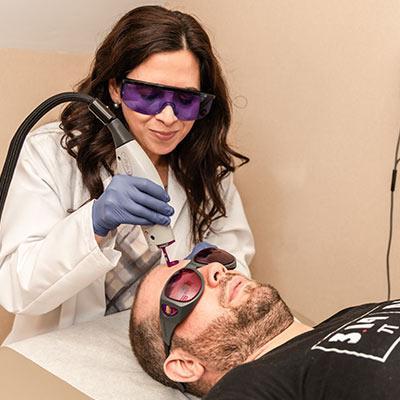Melasma, Vitiligo and Pigmentation
Melasma, vitiligo and pigmentation conditions affect the color of the skin. Skin color comes from a pigment known as melanin. When the cells that make melanin become unhealthy or damaged, the production of melanin is affected, causing skin discoloration.
There are skin pigmentation disorders that just manifest as patches on the skin while others can affect the entire body. Two examples of skin pigmentation disorders are melasma and vitiligo, both of which we treat at the Millburn Laser Center in New Jersey.
What are Melasma and Vitiligo?
Melasma, also known as hyperpigmentation, is a common skin condition that causes tan, brown, gray-brown patches or darkening of the skin to appear on the forehead, cheeks, nose, upper lip, and chin. It may also show up on areas that get a lot of sun exposure, such as the neck and forearms.
Melasma is sometimes referred to as the “mask of pregnancy” because it is common in pregnant women and it is believed to be triggered by the increase of hormones.
Vitiligo is a condition where the body’s immune system attacks the pigment cells that are responsible for your skin color causing white patches. These pigment cells are called melanocytes and no longer produce melanin. And without melanin production, areas of your skin lose their color or turn white.
The severity of the condition will vary from one individual to another. Some may only have small patches of pigment loss, while others may have vitiligo spread throughout their body.
Causes of Melasma and Vitiligo
It is not clear what causes melasma, but it typically occurs when the melanocytes produce too much color. This means that individuals with darker skin are more prone to the condition because they have more melanocytes compared to individuals with lighter skin. While the exact causes are unknown, melasma has common triggers which include:
- Sun exposure
- Hormonal changes
- Skincare products that irritate the skin
Vitiligo also does not have clear causes. However, many people with vitiligo also have a personal or family history of autoimmune disease, suggesting that vitiligo has an autoimmune cause. It sometimes “runs in families,” suggesting that genetics may play a role. Aside from having an immune system dysfunction, vitiligo is reported to appear after:
- Incidents of high levels of stress
- Severe sunburns and cuts
- Certain viruses
- Exposure to chemicals and toxins
Who Gets Melasma and Vitiligo?
According to the American Academy of Dermatology, melasma is more common in women. Only 10 percent of people who get melasma are men.
People with darker skin (e.g., African American, North African, Indian, Latin/Hispanic, Asian, Mediterranean, and Middle Eastern descent) are more prone to melasma.
Those with close blood relatives who have melasma are also at higher risk of getting the condition. Most people get Melasma on their cheeks, bridge of their nose, forehead, chin, and above their upper lip.
Vitiligo is more common than melasma. There are millions of people all over the world who have it. Almost half of those affected get it before they reach 21 years of age.
People of all races and genders have equal chances of getting vitiligo. Your risk of getting vitiligo increases if you have a close blood relative who has it or if you already have an autoimmune disease, particularly Hashimoto’s disease (a thyroid disease) or alopecia areata (hair loss).
The white patches may begin on your face above your eyes or on your neck, armpits, elbows, genitalia, hands or knees. They’re often symmetrical and can spread over your entire body. Michael Jackson is a known celebrity who had vitiligo.
Treatment for Melasma and Vitiligo
For some women, melasma can fade on its own. This typically occurs when a trigger, such as pregnancy or birth control pills, causes the melasma. Some melasma conditions can last for years, even a lifetime.
Melasma is one of the hardest dermatologic conditions to treat which is why you need a true expert, such as Millburn Laser Center in New Jersey.
Common treatments include medications such as hydroquinone, tretinoin, and corticosteroids, as well as other topical applications like azelaic acid or kojic acid. If topical treatments don’t work, certain procedures may be more successful. Examples are:
- Microdermabrasion
- Dermabrasion
- Chemical peel
- Laser Treatment
- Light therapy
There are people who choose not to receive treatment for vitiligo. They simply opt to use cosmetics to camouflage the lost color on their skin. This is recommended for children because it avoids possible side effects of taking medications.
For those who want to get treated for vitiligo or other skin pigmentation disorders, there are many options. The main goal of most treatments is to help restore your lost skin color. Examples include topical creams like corticosteroids and oral medications such as antibiotics and steroids.
There are also procedure options that include:
- Psoralen and Ultraviolet A (PUVA) therapy
- Narrowband UVB light therapy
- Laser treatment
- Depigmentation
When medicines and light therapy don’t work, surgery may be performed. Surgery may involve skin grafting, melanocyte transplants, or micropigmentation.
Frequently Asked Questions
Q: How Are Melasma And Vitiligo Diagnosed?
A: For melasma, the dermatologist can diagnose most patients just my examining their skin. The dermatologist may use a device called Wood’s Light or Wood’s Lamp to help detect skin pigmentation disorders. To rule out other skin conditions, a skin biopsy may be performed.
For vitiligo, the dermatologist will review your medical history, perform a physical exam, or take a blood sample. A blood test will be used to check the health of your thyroid gland. Thyroid disease is often associated with vitiligo.
Q: Can They Be Permanently Cured?
A: Melasma can only be permanently cured when there are no longer any hormonal imbalances that will trigger the condition’s reoccurrence. That along with consistent and adequate sun protection and limited sun exposure can help prevent the persistence of melasma.
There is no cure for vitiligo. Although there are effective treatments in restoring color, the condition’s recurrence cannot be prevented. Re-pigmentation or recovery may not be permanent.
Q: Are Melasma And Vitiligo Contagious?
A: No. These skin conditions cannot be passed by a local contact.
Q: Are There Any Self-Care Tips I Could Use?
A: The most important self-care measure you can take is sun protection. Whether you have melasma, vitiligo, or any other form of skin pigmentation, reducing sun exposure and wearing sunscreen can help keep your skin looking more even. The higher the SPF, the better. It is important to apply sunscreen because areas without pigmentation are more susceptible to sun damage and sunburns. Tanning will only add additional contrast to your skin and make patches more visible. Choose a non-chemical blocking sunscreen (with zinc and titanium dioxide formulas) so it can stop all the different wavelengths from coming through.
And don’t hesitate to wear cosmetics. Covering up pigmentation is a great temporary option to even your skin tone and can also boost confidence.
Get Effective Melasma, Vitiligo, and Pigmentation Treatments At Millburn Laser Center
Dealing with skin pigmentation disorders can sometimes be discouraging. Therefore, it is essential to have a professional and compassionate skin care specialist who can guide you through your treatment.
Schedule a consultation with Millburn Laser Center’s board-certified dermatologists so you can finally find your path to clear, healthy skin. Contact us at 973.376.8500 today.
Next, read about...
Mohs Micrographic Surgery
Considered the gold-standard treatment for certain skin cancers, Mohs surgery offers our patients the highest cure rates with the lowest risk of recurrence.
Dermal Fillers
Enhance facial contours and improve volume loss with dermal fillers, a completely noninvasive treatment to achieve your aesthetic goals without any downtime.
Laser Treatments
Whether you want to reduce fine lines and pigmentation or remove an unwanted tattoo or hair, with over 25 available lasers, we can tailor a treatment to your unique needs.
Make An Appointment
PATIENT APPROVED
Trusted by Thousands
We are honored so many residents of Millburn and central New Jersey choose us as their family dermatologist.
"From the moment I walked into the practice I was impressed!"
"Millburn laser center and dermatology office are great!"
"The team of professional dermatologists helped guide me."
Opening Hours
Monday: 7:30am - 7:00pm
Tuesday: 7:30am - 4:00pm
Wednesday: 9:00am - 5:00pm
Thursday: 7:30am - 7:00pm
Friday: 9:00am - 5:00pm
Saturday: Please call the office for available Saturday appointments.
Same-Day Appointments Now Available
Phone
Office: 973.376.8500
Fax: 973.376.6295
Location
12 East Willow Street.
Millburn, NJ 07041
Contact Us:
Serving all of central New Jersey!
Associates In Dermatology
Millburn Laser Center
12 East Willow Street
Millburn, NJ 07041
Areas We Serve

5 stars
Based on 1834 reviews


©2024 Schweiger Dermatology Group. All Rights Reserved. Sitemap | Privacy Policy | The information available on this web site is provided for informational purposes only. This information is not intended to replace a medical consultation where a physician's judgment may advise you about specific disorders, conditions and or treatment options. We hope the information will be useful for you to become more educated about your health care decisions. If you are vision-impaired or have some other impairment covered by the Americans with Disabilities Act or a similar law, and you wish to discuss potential accommodations related to using this website, please contact us at 973.376.8500



